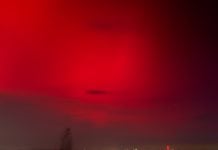On May 1st at Cape Canaveral, SpaceX launched a classified satellite (USA 276) for the US National Reconnaissance Office.
On June 3rd, USA 276 made a close approach and effectively circled the ISS.

On May 1st at Cape Canaveral, SpaceX launched a classified satellite (USA 276). Watching the spysat go into orbit, analysts around the world quickly realized something odd. The orbit of USA 276 was similar to that of the International Space Station and could theoretically make close approaches to the orbiting outpost.
On June 3rd, that’s exactly what happened. “USA 276 made a close approach and effectively circled the ISS,” reports Marco Langbroek of Leiden, the Netherlands. He prepared this diagram showing the circumstances of the encounter:
Amateur satellite watchers have been tracking USA 276 since late May, and their observations have resulted in ever-improving estimates of the satellite’s orbit. “With the latest data included, we can establish the moment of closest approach as 3 June 2017, 14:01:52 UT. It happened in daylight over the southern Atlantic north of the Falklands, near 43o.75 S, 45o.45 W, with a miss distance of only 6.4 ± 2 km.” USA 276 looped around the ISS.

Why is an American spy satellite buzzing the ISS?
Maybe it’s a chance encounter. Senior satellite analyst Ted Molczan has published arguments for and against that possibility. “I am inclined to believe that the close conjunctions between USA 276 and ISS are intentional,” he says.
Molczan points out that USA 276 might be visiting the ISS to test Raven, a technology demonstration project on the ISS researchers are using to develop spacecraft autopilot systems. Raven has visible, infrared, and lidar sensors that can track incoming spacecraft, feeding the data to an onboard processor for decision-making about rendezvous and docking.
If USA 276 does return to the ISS, observers will probably know about it. Langbroek has photographed the spysat in the night sky and it is visible to the unaided eye, like a dim 3rd magnitude star.













[…] […]